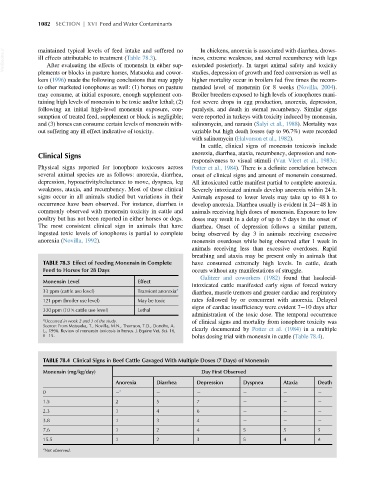Page 1150 - Veterinary Toxicology, Basic and Clinical Principles, 3rd Edition
P. 1150
1082 SECTION | XVI Feed and Water Contaminants
VetBooks.ir maintained typical levels of feed intake and suffered no iness, extreme weakness, and sternal recumbency with legs
In chickens, anorexia is associated with diarrhea, drows-
ill effects attributable to treatment (Table 78.3).
extended posteriorly. In target animal safety and toxicity
After evaluating the effects of monensin in either sup-
plements or blocks in pasture horses, Matsuoka and cowor- studies, depression of growth and feed conversion as well as
kers (1996) made the following conclusions that may apply higher mortality occur in broilers fed five times the recom-
to other marketed ionophores as well: (1) horses on pasture mended level of monensin for 8 weeks (Novilla, 2004).
may consume, at initial exposure, enough supplement con- Broiler breeders exposed to high levels of ionophores mani-
taining high levels of monensin to be toxic and/or lethal; (2) fest severe drops in egg production, anorexia, depression,
following an initial high-level monensin exposure, con- paralysis, and death in sternal recumbency. Similar signs
sumption of treated feed, supplement or block is negligible; were reported in turkeys with toxicity induced by monensin,
and (3) horses can consume certain levels of monensin with- salinomycin, and narasin (Salyi et al., 1988). Mortality was
out suffering any ill effect indicative of toxicity. variable but high death losses (up to 96.7%) were recorded
with salinomycin (Halvorson et al., 1982).
In cattle, clinical signs of monensin toxicosis include
Clinical Signs anorexia, diarrhea, ataxia, recumbency, depression and non-
responsiveness to visual stimuli (Van Vleet et al., 1983c;
Physical signs reported for ionophore toxicoses across Potter et al., 1984). There is a definite correlation between
several animal species are as follows: anorexia, diarrhea, onset of clinical signs and amount of monensin consumed.
depression, hypoactivity/reluctance to move, dyspnea, leg All intoxicated cattle manifest partial to complete anorexia.
weakness, ataxia, and recumbency. Most of these clinical Severely intoxicated animals develop anorexia within 24 h.
signs occur in all animals studied but variations in their Animals exposed to lower levels may take up to 48 h to
occurrence have been observed. For instance, diarrhea is develop anorexia. Diarrhea usually is evident in 24 48 h in
commonly observed with monensin toxicity in cattle and animals receiving high doses of monensin. Exposure to low
poultry but has not been reported in either horses or dogs. doses may result in a delay of up to 5 days in the onset of
The most consistent clinical sign in animals that have diarrhea. Onset of depression follows a similar pattern,
ingested toxic levels of ionophores is partial to complete being observed by day 3 in animals receiving excessive
anorexia (Novilla, 1992). monensin overdoses while being observed after 1 week in
animals receiving less than excessive overdoses. Rapid
breathing and ataxia may be present only in animals that
TABLE 78.3 Effect of Feeding Monensin in Complete have consumed extremely high levels. In cattle, death
Feed to Horses for 28 Days occurs without any manifestations of struggle.
Galitzer and coworkers (1982) found that lasalocid-
Monensin Level Effect
intoxicated cattle manifested early signs of forced watery
33 ppm (cattle use level) Transient anorexia a diarrhea, muscle tremors and greater cardiac and respiratory
121 ppm (broiler use level) May be toxic rates followed by or concurrent with anorexia. Delayed
signs of cardiac insufficiency were evident 7 10 days after
330 ppm (10 3 cattle use level) Lethal
administration of the toxic dose. The temporal occurrence
a
Occurred in week 2 and 3 of the study. of clinical signs and mortality from ionophore toxicity was
Source: From Matsuoka, T., Novilla, M.N., Thomson, T.D., Donoho, A.
L., 1996. Review of monensin toxicosis in horses. J. Equine Vet. Sci. 16, clearly documented by Potter et al. (1984) in a multiple
8 15. bolus dosing trial with monensin in cattle (Table 78.4).
TABLE 78.4 Clinical Signs in Beef Cattle Gavaged With Multiple Doses (7 Days) of Monensin
Monensin (mg/kg/day) Day First Observed
Anorexia Diarrhea Depression Dyspnea Ataxia Death
0 a
1.5 2 5 7
2.3 1 4 6
3.8 1 3 4
7.6 1 2 4 5 5 5
15.5 1 2 3 5 4 4
a
Not observed.

